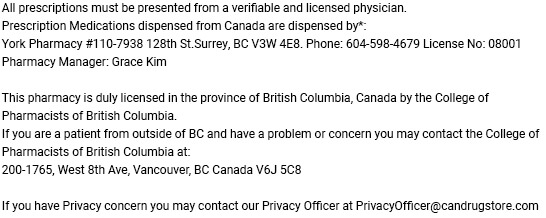Description
Indications
Sotalol is indicated for the treatment of a potentially fatal cardiac condition known as ventricular arrhythmia. It can also be prescribed for the management of cardiac rhythm disorders such as atrial fibrillation or atrial flutter.
Functioning as a beta-blocker, sotalol exerts its effects by modulating the response of specific regions within the body, notably the heart, to neural stimuli. Consequently, it promotes a reduction in heart rate and facilitates the establishment of a steady and regular cardiac rhythm.
Uses and Dosage
Follow your doctor’s instructions when taking this medication orally, typically 1 to 3 times a day. You have the option to take it with or without food. Select one method and consistently adhere to it for each dose.
If you are utilizing the liquid formulation of this medication, employ a specialized measuring device or spoon to accurately measure the prescribed dose. Household spoons should be avoided as they may lead to incorrect dosing.
The dosage of this medication is determined based on your medical condition and response to treatment. For children, dosage considerations also account for their age and body size.
Consistent and regular use of this medication is essential in order to derive maximum benefit from its therapeutic effects. To aid in adherence, establish a routine of taking it at the same time(s) each day.
If you are concurrently using antacids containing aluminum or magnesium, avoid taking them simultaneously with sotalol. These antacids can bind to sotalol, diminishing its absorption and efficacy. To mitigate this interaction, separate the administration of these antacids and sotalol by at least 2 hours.
Refrain from exceeding the prescribed dosage, as doing so may heighten the risk of side effects, including the emergence of a new and severe abnormal heartbeat. Do not reduce the dosage or skip doses unless specifically instructed by your doctor. Improper adherence to sotalol can increase the likelihood of a recurrence of fast or irregular heartbeats. Ensure you have an ample supply of this medication and refill it several days in advance to avoid running out of pills.
Side Effects
Some side effects may occur that usually do not need medical attention:
- dizziness
- lightheadedness
- excessive tiredness
- headache
- constipation
- diarrhea
- upset stomach
- muscle aches
Inform your healthcare provider immediately if you experience any serious side effects:
- shortness of breath or wheezing
- swelling of the feet and lower legs
- chest pain
Caution
Prior to initiating sotalol therapy, inform your doctor or pharmacist about any known allergies you may have, including allergies to sotalol or other substances. This product may contain inactive ingredients that can elicit allergic reactions or other complications.
Before using this medication, disclose your medical history to your doctor or pharmacist, particularly if you have certain heart rhythm disorders, kidney problems, heart conditions, respiratory issues, overactive thyroid (hyperthyroidism), or a history of severe allergic reactions requiring treatment with epinephrine.
Sotalol may cause a heart rhythm condition known as QT prolongation, as observed in an electrocardiogram (EKG). QT prolongation, although rare, can result in serious (and rarely fatal) instances of fast or irregular heartbeat, accompanied by symptoms such as severe dizziness or fainting, which necessitate immediate medical attention.
Insufficient levels of potassium or magnesium in the blood can also heighten the risk of QT prolongation. This risk may be further exacerbated by the concurrent use of certain medications (such as diuretics or “water pills”), a compromised ability to consume normal food and fluids, or conditions such as severe or prolonged sweating, diarrhea, or vomiting.
This medication may induce dizziness. The consumption of alcohol or marijuana can intensify dizziness. Refrain from driving, operating machinery, or engaging in activities that require alertness until you are confident in your ability to do so safely.
This product may impede the typical occurrence of a rapid or pounding heartbeat that signifies low blood sugar levels (hypoglycemia). The risk of this effect is elevated in individuals with diabetes, those experiencing vomiting, fasting, or irregular eating patterns. Other symptoms of low blood sugar, such as dizziness and sweating, remain unaffected by this drug.
For individuals with diabetes, this medication may make it more challenging to regulate blood sugar levels. Regularly monitor blood sugar levels as directed by your doctor, and promptly notify them if you exhibit symptoms of high blood sugar, such as increased thirst or urination. Your doctor may need to adjust your diabetes medication, exercise regimen, or diet accordingly.
Children using this medication, especially those who are vomiting or experiencing irregular eating patterns, may be at greater risk of developing low blood sugar (hypoglycemia). To minimize this risk, ensure that children maintain regular eating habits. If your child is unable to eat regularly, is vomiting, or exhibits symptoms of low blood sugar (e.g., sweating, trembling), promptly inform the doctor.
Older adults may be more susceptible to the side effects of this medication, particularly dizziness, fatigue, and QT prolongation.
During pregnancy, this medication should only be used when clearly necessary, as it may pose risks to the unborn baby. Discuss the potential benefits and risks with your doctor.
This medication passes into breast milk and may have adverse effects on nursing infants. Prior to breastfeeding, discuss the risks and benefits of sotalol with your doctor.
Form and Strength
Betapace is available in the following forms and strengths:
-
Betapace tablet:
- 80mg
- 160mg
-
sotalol tablet:
- 80mg
- 120mg
- 160mg
- 240mg
FAQ
Does Betapace lower blood pressure?
Betapace lowers your blood pressure and heart rate.
How long does it take for Betapace to work?
Betapace starts to work after about 4 hours, but it can take 2 to 3 days to fully take effect.
Resources
- https://www.goodrx.com/sotalol/what-is#faqs
- https://www.nhs.uk/medicines/sotalol/#:~:text=Sotalol%20starts%20to%20work%20after,the%20rest%20of%20your%20life
- https://www.mayoclinic.org/drugs-supplements/sotalol-oral-route/description/drg-20071203
- https://medlineplus.gov/druginfo/meds/a693010.html
- https://www.webmd.com/drugs/2/drug-9023/betapace-oral/details
- https://www.drugs.com/betapace.html


 Prescription Required
Prescription Required  Formulation :
Formulation : 




